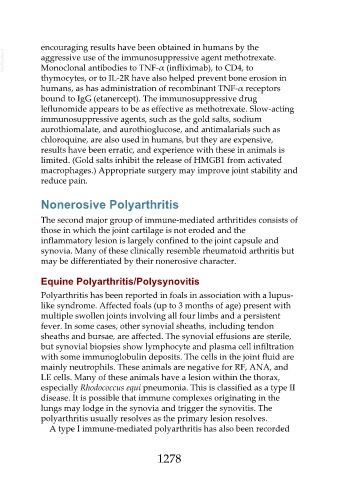Page 1278 - Veterinary Immunology, 10th Edition
P. 1278
encouraging results have been obtained in humans by the
VetBooks.ir aggressive use of the immunosuppressive agent methotrexate.
Monoclonal antibodies to TNF-α (infliximab), to CD4, to
thymocytes, or to IL-2R have also helped prevent bone erosion in
humans, as has administration of recombinant TNF-α receptors
bound to IgG (etanercept). The immunosuppressive drug
leflunomide appears to be as effective as methotrexate. Slow-acting
immunosuppressive agents, such as the gold salts, sodium
aurothiomalate, and aurothioglucose, and antimalarials such as
chloroquine, are also used in humans, but they are expensive,
results have been erratic, and experience with these in animals is
limited. (Gold salts inhibit the release of HMGB1 from activated
macrophages.) Appropriate surgery may improve joint stability and
reduce pain.
Nonerosive Polyarthritis
The second major group of immune-mediated arthritides consists of
those in which the joint cartilage is not eroded and the
inflammatory lesion is largely confined to the joint capsule and
synovia. Many of these clinically resemble rheumatoid arthritis but
may be differentiated by their nonerosive character.
Equine Polyarthritis/Polysynovitis
Polyarthritis has been reported in foals in association with a lupus-
like syndrome. Affected foals (up to 3 months of age) present with
multiple swollen joints involving all four limbs and a persistent
fever. In some cases, other synovial sheaths, including tendon
sheaths and bursae, are affected. The synovial effusions are sterile,
but synovial biopsies show lymphocyte and plasma cell infiltration
with some immunoglobulin deposits. The cells in the joint fluid are
mainly neutrophils. These animals are negative for RF, ANA, and
LE cells. Many of these animals have a lesion within the thorax,
especially Rhodococcus equi pneumonia. This is classified as a type II
disease. It is possible that immune complexes originating in the
lungs may lodge in the synovia and trigger the synovitis. The
polyarthritis usually resolves as the primary lesion resolves.
A type I immune-mediated polyarthritis has also been recorded
1278

